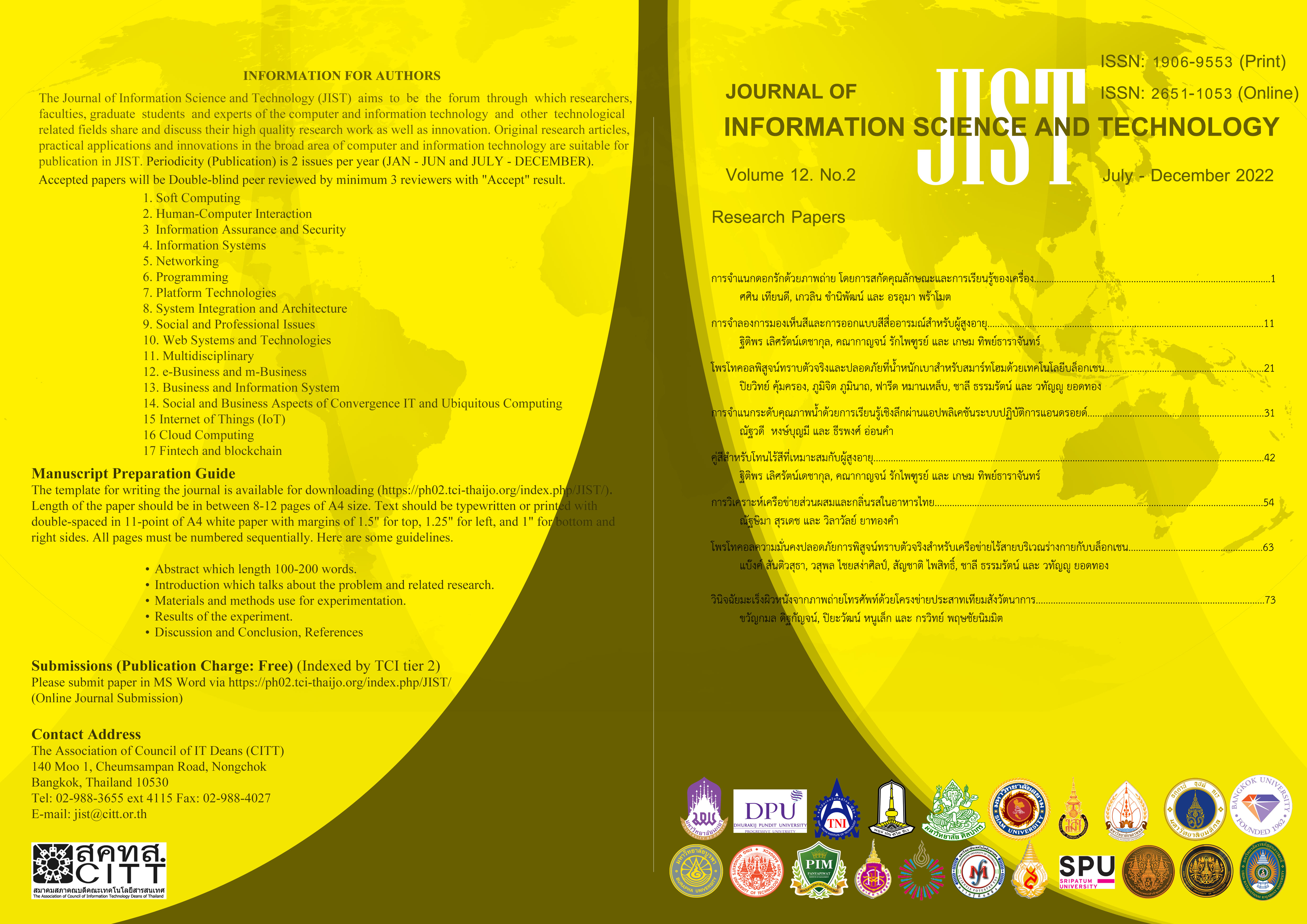การจำแนกระดับคุณภาพน้ำด้วยการเรียนรู้เชิงลึกผ่านแอปพลิเคชันระบบปฏิบัติการแอนดรอยด์
Main Article Content
บทคัดย่อ
น้ำเป็นสิ่งจำเป็นอย่างยิ่งต่อการดำรงชีวิตและการยังชีพของสิ่งมีชีวิตทั้งหมด ในช่วงไม่กี่ปีที่ผ่านมาคุณภาพน้ำในแหล่งน้ำได้รับผลกระทบจากของเสียและสารมลพิษเพิ่มมากขึ้น การตรวจสอบคุณภาพน้ำเป็นสิ่งสำคัญต่อการจัดการระบบนิเวศและทรัพยากรน้ำดังนั้น งานวิจัยนี้จึงนำเสนอการตรวจสอบคุณภาพน้ำโดยประยุกต์ใช้เทคนิคการเรียนรู้เชิงลึกเพื่อจำแนกระดับคุณภาพน้ำจากภาพแบบอัตโนมัติผ่านแอปพลิเคชันระบบปฏิบัติการแอนดรอยด์ขั้นตอนการดำเนินการ ประกอบด้วย การรวบรวมชุดข้อมูลภาพจำนวนทั้งหมด 480 ภาพ แบ่งออกเป็น 4ประเภท ได้แก่ คุณภาพน้ำเกรด A เกรด B เกรด C และเกรด Dนำข้อมูลภาพไปฝึกสอนให้เครื่องคอมพิวเตอร์เรียนรู้และสร้างโมเดลจำแนกระดับคุณภาพน้ำแต่ละประเภททดลองเปรียบเทียบด้วยอัลกอริทึม 3แบบ ได้แก่ MobileNet0.5MobileNet 0.75 และ MobileNet 1.0การประเมินประสิทธิภาพโมเดลใช้ค่าความถูกต้อง ความแม่นยำ และความระลึก จากนั้นนำโมเดลไปพัฒนาเป็นแอปพลิเคชันและขั้นตอนสุดท้ายคือการทดสอบประสิทธิภาพแอปพลิเคชัน ผลการทดลองพบว่า(1) โมเดลMobileNet 1.0 มีความเหมาะสมมากที่สุด โดยการวัดประสิทธิภาพด้วยค่าความถูกต้องได้100.00%ค่าความแม่นยำ 100.00% ค่าความระลึก 100.00%และ (2) ผลการทดสอบประสิทธิภาพแอปพลิเคชันพบว่า อัตราความสำเร็จในการจำแนกภาพเท่ากับ82.50%มีประสิทธิภาพความแม่นยำอยู่ในระดับดี ส่วนผลการประเมินคุณภาพแอปพลิเคชันจากผู้เชี่ยวชาญ มีค่าเฉลี่ย 4.33 อยู่ในระดับมีความเหมาะสมมาก ผลการทดลองทั้งหมดแสดงให้เห็นว่าวิธีการและแอปพลิเคชันที่นำเสนอนี้สามารถนำไปใช้ประโยชน์ในการเป็นเครื่องมือช่วยตรวจสอบวิเคราะห์คุณภาพน้ำจากภาพถ่ายได้อย่างมีประสิทธิภาพและง่ายต่อการใช้งาน
Article Details
This work is licensed under a Creative Commons Attribution-NonCommercial-NoDerivatives 4.0 International License.
I/we certify that I/we have participated sufficiently in the intellectual content, conception and design of this work or the analysis and interpretation of the data (when applicable), as well as the writing of the manuscript, to take public responsibility for it and have agreed to have my/our name listed as a contributor. I/we believe the manuscript represents valid work. Neither this manuscript nor one with substantially similar content under my/our authorship has been published or is being considered for publication elsewhere, except as described in the covering letter. I/we certify that all the data collected during the study is presented in this manuscript and no data from the study has been or will be published separately. I/we attest that, if requested by the editors, I/we will provide the data/information or will cooperate fully in obtaining and providing the data/information on which the manuscript is based, for examination by the editors or their assignees. Financial interests, direct or indirect, that exist or may be perceived to exist for individual contributors in connection with the content of this paper have been disclosed in the cover letter. Sources of outside support of the project are named in the cover letter.
I/We hereby transfer(s), assign(s), or otherwise convey(s) all copyright ownership, including any and all rights incidental thereto, exclusively to the Journal, in the event that such work is published by the Journal. The Journal shall own the work, including 1) copyright; 2) the right to grant permission to republish the article in whole or in part, with or without fee; 3) the right to produce preprints or reprints and translate into languages other than English for sale or free distribution; and 4) the right to republish the work in a collection of articles in any other mechanical or electronic format.
We give the rights to the corresponding author to make necessary changes as per the request of the journal, do the rest of the correspondence on our behalf and he/she will act as the guarantor for the manuscript on our behalf.
All persons who have made substantial contributions to the work reported in the manuscript, but who are not contributors, are named in the Acknowledgment and have given me/us their written permission to be named. If I/we do not include an Acknowledgment that means I/we have not received substantial contributions from non-contributors and no contributor has been omitted.
References
N. Tangkhananurak and K. Tangkhananurak, Principles of chemical water quality analysis. Bangkok: Kasetsart University Press, 2007.
Department of Health, “Water quality criteria,” Department of Health Laboratory Center, 2021. [Online]. Available:https:// rldc.anamai.moph.go.th/th/water-quality-standards [Accessed: Aug. 9, 2021].
Department of National Parks Wildlife and Plant Conservation, “Water quality of the basin,” Department of National Parks Wildlife and Plant Conservation, 2021. [Online]. Available:https://www.dnp.go.th/Research/watershade/qullity.html [Accessed: Sep. 19, 2021].
Pollution Control Department, “Water quality and water pollution,” Pollution Control Department, 2021.[Online]. Available: https://www.pcd.go.th/faqs/waterqualityandwaterpollution [Accessed: Sep. 12, 2021].
K. Sraubon, LearnAI:Deep Learning with Python. Bangkok: Intermedia Press, 2022.
N. Phromrit and S. Wichanya, Fundamental of Deep Learning in Practice. Bangkok: IDC Premier, 2021.
G. Lin, and W. Shen, “Research on Convolutional Neural Network based on Improved Relu - piecewise Activation Function,” Procedia Computer Science, vol. 131, no.1,pp. 977-984, 2018.
F. Pu, C. Ding, Z. Chao, Y. Yu, and X. Xu, “Water-Quality Classification of Inland Lakes Using Landsat8 Images by Convolutional Neural Networks,” Remote Sensing, vol. 11, no. 14, pp. 1674-1688, 2019.
A. Mahmood, M. Bennamoun, S. An, F. Sohel, F. Boussaid,R. Hovey, G. Kendrick,and R. Fisher, “Automatic annotation of coral reefs using deep learning,” In Proceedings of OCEANS 2016 MTS/IEEE Monterey, pp. 1-5, 2016.
R. Barzegar, M. Aalami and J. Adamowski, “Short-term water quality variable prediction using hybrid CNN-LSTM deep learning model,” Stochastic Environmental Research and Risk Assessment, vol. 34, no. 1, pp. 415-433, 2020.
J. Orlando, E. Prokofyeva,M. Fresno and M. Blaschko, “An ensemble deep learning based approach for red lesion detection in fundus images,” Computer Methods and Programs in Biomedicine, vol. 2018, no. 153, pp. 115-127, 2018.
S. Krishnan, S. Antani and S. Jaeger, “Visualizing Deep Learning Activations for Improved Malaria Cell Classification,”In Proceedings of First workshop Medical Informatics and Healthcare, Machine Learning Research, pp. 1-8, 2017.
H. Wu and Z. Zhou, “Using convolution neural network for defective image classification of industrial components,” Mobile Information Systems, vol. 2021, no. 1, pp. 1-8, 2021.
D. Sinha and M. El-Sharkawy, “Thin MobileNet: An Enhanced MobileNet Architecture,” In Proceedings of IEEE 10th Annual Ubiquitous Computing, Electronics & Mobile Communication Conference (UEMCON2019), pp. 0280-0285, 2019.
T. Arfan, M. Hayaty, and A. Hadinegoro, “Classification of Brain Tumours Types based on MRI Images using Mobilenet,” In Proceedings of 2ndInternationalConference on Innovation and Creative Information Technology (ICITech2021), pp. 69-73, 2021.
S. Naseer, MR Ali, A. Muneer, and A. Fati, “iAmideV-Deep: ValineAmidation Site Prediction in Proteins Using Deep Learning and Pseudo Amino Acid Composition,” Symmetry, vol. 2021, no. 13, pp. 1-19, 2021.


